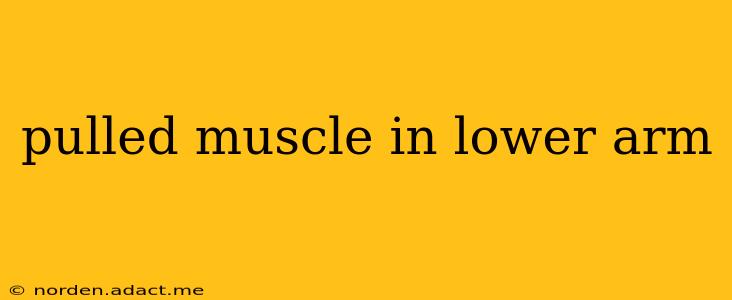A pulled muscle in your lower arm, also known as a forearm strain, is a common injury affecting the muscles responsible for flexing and extending your wrist and fingers. This painful condition can significantly impact your daily activities, particularly if you rely on your hands for work or hobbies. Understanding the causes, symptoms, and effective treatment options is crucial for faster recovery and preventing future occurrences. This guide will delve into the intricacies of forearm strains, providing comprehensive information to help you navigate this challenging injury.
What Causes a Pulled Muscle in the Lower Arm?
Forearm strains typically result from overuse, sudden forceful movements, or direct trauma to the muscles. Let's break down the common culprits:
-
Repetitive movements: Activities involving repetitive wrist movements, such as typing, using power tools, or playing certain sports (e.g., tennis, golf), can progressively strain the forearm muscles. The cumulative effect of these repeated actions leads to microscopic tears in the muscle fibers.
-
Sudden forceful contractions: Unexpected twists, falls, or lifting heavy objects can cause a sudden, powerful contraction of the forearm muscles, resulting in a more severe strain. This often involves a sharp, tearing sensation.
-
Direct impact: A direct blow to the forearm, such as a sports injury or accident, can also result in muscle damage.
-
Improper lifting techniques: Incorrect lifting techniques can place excessive stress on the forearm muscles, increasing the risk of strains.
-
Underlying medical conditions: In some cases, pre-existing medical conditions like muscle imbalances or nerve disorders can predispose individuals to forearm strains.
What are the Symptoms of a Pulled Forearm Muscle?
Recognizing the symptoms of a forearm strain is crucial for prompt treatment. Common signs include:
- Pain: This is the primary symptom, ranging from mild aching to severe, sharp pain, especially during movement.
- Swelling: Inflammation and swelling may develop around the affected area.
- Bruising: Bruising (ecchymosis) may appear, indicating bleeding within the muscle tissue.
- Stiffness: Difficulty moving or bending your wrist and fingers is common.
- Weakness: You might experience weakness in your grip strength or reduced ability to perform fine motor tasks.
- Limited range of motion: You may have trouble fully extending or flexing your wrist and fingers.
How is a Pulled Forearm Muscle Treated?
Treatment for a pulled forearm muscle typically focuses on reducing pain and inflammation and promoting healing. The approach depends on the severity of the injury:
-
RICE Method: For mild strains, the RICE method (Rest, Ice, Compression, Elevation) is often effective. Resting the arm, applying ice packs, using a compression bandage, and elevating the arm above the heart can reduce swelling and pain.
-
Over-the-counter pain relievers: Nonsteroidal anti-inflammatory drugs (NSAIDs) like ibuprofen or naproxen can help manage pain and inflammation.
-
Physical therapy: A physical therapist can design a rehabilitation program that includes exercises to improve range of motion, strength, and flexibility. This is especially important for moderate to severe strains.
-
Splinting or bracing: In some cases, a splint or brace may be necessary to immobilize the arm and promote healing.
-
Medical attention: Seek medical attention if the pain is severe, persistent, or accompanied by significant swelling, bruising, or numbness. A doctor may order imaging tests (X-rays or MRI) to rule out other injuries.
How Long Does it Take to Recover from a Pulled Forearm Muscle?
Recovery time varies depending on the severity of the strain. Mild strains may heal within a few days to a couple of weeks with proper rest and self-care. More severe strains may require several weeks or even months of rehabilitation. Consistent adherence to the treatment plan and following your physical therapist's instructions are crucial for optimal recovery.
How Can I Prevent a Pulled Forearm Muscle?
Preventing forearm strains involves adopting preventative measures:
-
Warm-up before activity: Always warm up your muscles before engaging in activities that involve repetitive wrist movements or forceful contractions.
-
Proper lifting techniques: Learn and use proper lifting techniques to minimize strain on your forearm muscles.
-
Ergonomic workstation: Ensure your workstation is ergonomically designed to reduce strain on your wrists and arms.
-
Regular stretching: Regular stretching exercises can improve flexibility and reduce the risk of muscle strains.
-
Strength training: Strengthening the forearm muscles can improve their resilience and reduce susceptibility to injury.
Can a pulled forearm muscle be prevented?
Yes, a pulled forearm muscle can often be prevented by following the strategies outlined above. By taking proactive steps to protect your muscles, you can significantly reduce your risk of injury.
What are some home remedies for a pulled forearm muscle?
Home remedies for a mild pulled forearm muscle include the RICE method (rest, ice, compression, elevation), over-the-counter pain relievers like ibuprofen, and gentle stretching once the initial pain subsides. Always consult a doctor for more serious injuries.
When should I see a doctor for a pulled forearm muscle?
Seek medical attention if the pain is severe, persistent, or accompanied by significant swelling, bruising, or numbness. A doctor can properly diagnose the injury and recommend appropriate treatment.
This comprehensive guide provides valuable information on pulled forearm muscles. Remember, early intervention and proper treatment are key to a swift recovery. If you have any concerns about a forearm injury, consulting a healthcare professional is always recommended.
